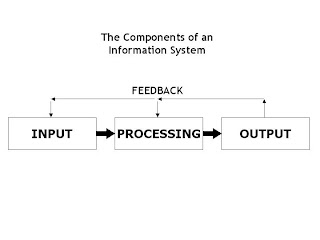Information system is a set of interrelated elements or components that collect (input), manipulate (process), and disseminate (output) data and information, that provide feedback mechanism to meet an objective. Input is the activity of gathering and capturing raw data. Input can take in many forms, it can be manual process, or may be automated. Regardless of the input method, accurate input is critical to achieve the desired output. Processing involves converting or transforming data into useful outputs. Processing can involves making calculations, making comparisons and taking alternative actions, and storing data for future use. It can be done manually or with the assistance of computers. Output involves producing useful information, usually in the form of documents and reports. In some cases, output from one system can also become an input for another system. Output can be produced in a variety of ways. For a computer, printers and display screens are the common output devices. However, output can also be manual process involving handwritten reports and documents. Feedback is output that is used to make changes to input or processing activities. Errors or problems might make it necessary to correct input data or change a process. In information system, errors or exceptional reports can be generated to provide feedbacks. Feedback is also important for managers and decision makers. Output from an information system might indicate business and resources status as feedback to the managers or decision makers. Feedback can also be in the form of prediction of future events, which are called Forecasting. It can estimates the future performance of the organization and helps to avoid problems. Information system uses new technology to perform important tasks like handling of daily transactions, improve company productivity and help management to make decisions. Data, Software, Hardware, Procedures and People are the key elements of an information system. Business Information System is used specifically to help in the business related functions. It consists a series of subsystems that processes data into useful information. Each subsystem has its own purpose and functions. However, most subsystems are interdependent. Proper definitions and coordination allow multiple subsystems to connect and provide useful information for the management. There are six broad categories of Business Information Systems. Operational Systems / Transactional Processing Systems (TPS) Management Information Systems (MIS) Decision Support Systems (DSS) Office Automation Systems (OAS) Expert Systems (ES) | |
Showing posts with label Business Information Systems. Show all posts
Showing posts with label Business Information Systems. Show all posts
14.10.08
WHAT IS INFORMATION SYSTEM?
Subscribe to:
Posts (Atom)
